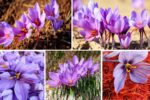When most people hear “tobacco,” they think of cigarettes — but in the world of horticulture, tobacco plants offer far more than their commercial reputation. These fast-growing, ornamental plants belong to the Nicotiana genus and are valued for their striking foliage, fragrant flowers, and unique garden presence. Some varieties are cultivated for their decorative blooms, while others boast fascinating growth habits, colors, or adaptability to different climates.
Let’s explore 5 fascinating tobacco plants known for their distinctive growing characteristics and garden appeal.

1. Nicotiana tabacum (Common Tobacco)
Nicotiana tabacum is the most widely cultivated tobacco species globally, traditionally grown for its large, broad leaves used in the production of tobacco products. This annual plant can reach heights of 6 feet, making it a striking feature in gardens and landscapes. Its tall stems bear clusters of tubular, pink flowers that bloom in summer and attract hummingbirds and pollinators. Beyond its commercial value, Nicotiana tabacum adds bold texture and vertical interest to ornamental beds. It thrives in full sun and fertile, well-drained soil, and while it requires regular watering, it’s surprisingly resilient once established.

2. Nicotiana sylvestris (Woodland Tobacco)
Known as the Queen of Nicotianas, Nicotiana sylvestris is an elegant ornamental plant famed for its tall, graceful stems and long, trumpet-shaped white flowers. This towering beauty can grow up to 5–6 feet tall and releases a sweet, jasmine-like fragrance in the evening, making it a fantastic addition to moon gardens or nighttime patios. Native to South America, it prefers rich, moist soil and partial to full sun. Its lush, broad leaves form a striking base, while its slender, dangling blooms draw moths and pollinators after sunset, creating a magical evening garden experience.

3. Nicotiana alata (Jasmine Tobacco)
Nicotiana alata is a versatile flowering tobacco species cherished for its colorful, star-shaped blossoms and delightful scent. Available in shades of white, pink, red, lime green, and purple, this plant offers a burst of color in garden beds and borders. Its flowers open during the evening and release a heady fragrance that attracts nocturnal pollinators like moths. Growing to around 3–5 feet tall, Nicotiana alata thrives in sunny, sheltered spots with well-draining soil. It’s often grown as an annual in cooler regions and makes an excellent companion plant for moon gardens or pollinator-friendly landscapes.

4. Nicotiana rustica (Aztec Tobacco)
A robust and ancient species, Nicotiana rustica is known for its high nicotine content and historical use in ceremonial rituals by indigenous cultures in the Americas. This fast-growing plant typically reaches 3–5 feet in height and produces clusters of small, tubular yellow-green flowers. Its distinctive, rounded leaves grow densely along thick stems, creating a bushy appearance. Nicotiana rustica is hardy and adaptable, thriving in a variety of soil types and tolerating both full sun and partial shade. While traditionally grown for its powerful leaves, it’s increasingly appreciated as a resilient and unique ornamental in medicinal and historic gardens.

5. Nicotiana langsdorffii (Langsdorff’s Tobacco)
Nicotiana langsdorffii is a unique and exotic-looking flowering tobacco species native to South America. Distinguished by its tall, wiry stems and clusters of bell-shaped, lime-green flowers, this plant adds an unusual color and texture to ornamental borders and cottage gardens. Its long-lasting blooms and subtle, understated fragrance attract hummingbirds and bees throughout the summer. Growing to about 4–5 feet, Nicotiana langsdorffii prefers full sun or partial shade and thrives in moderately fertile, well-drained soil. Gardeners prize this variety for its uncommon hue and airy, architectural growth habit that pairs beautifully with bold or dark-colored flowers.
Final Thoughts
Tobacco plants are far more than their commercial use. From the lush, leafy presence of Nicotiana tabacum to the enchanting, evening fragrance of Nicotiana sylvestris, these plants offer unique textures, heights, and colors to enrich any garden space. Whether you’re drawn to historic heirlooms like Aztec Tobacco or exotic varieties like Langsdorff’s Tobacco, these species prove that tobacco plants can be ornamental showstoppers, pollinator magnets, and conversation starters in your backyard.
Would you like me to create a planting and care guide for these tobacco varieties too? I’d be happy to put that together next!





